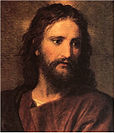Anglican Communion
 From Conservapedia
From Conservapedia The Anglican Communion is the third largest Christian division in the world after Roman Catholicism and Eastern Orthodoxy. The Anglican Communion functions as a worldwide body of associated Anglican churches in full communion with the Archbishop of Canterbury. There are also a few churches that are not Anglican but have been received into full communion with the Anglican Communion, for instance the national churches of Scandinavia. Conversely, there are Anglican churches, accounting for approximately one-third of the world's Anglicans, which do not belong to the Anglican Communion. The Church of England is often seen as the Mother Church of the Anglican Communion and all Anglican churches.
Leadership[edit]
The British monarch (currently, Queen Elizabeth II) is the Supreme Governor of the Church of England, the mother church of the Anglican Communion. The British Monarch has also, since the time of King Henry VIII, held the title 'Defender of the Faith'. A law dating from 1701, still in effect, prevents a Roman Catholic or spouse of a Roman Catholic from becoming king or queen. [1]
The Archbishop of Canterbury, the head of the Holy See of Canterbury, is the head of the Communion and is seen sometimes, but erroneously, as the 'Anglican Pope.' Unlike a Pope, his official pronouncements are not considered binding on all Anglicans and his jurisdiction is limited to England.
The principal book of worship in Anglican churches is the Book of Common Prayer, created by Thomas Cranmer.
Some of the Churches in Full Communion[edit]
- Church of England
- Anglican Church in Australia
- Anglican Church of Canada
- Anglican Church of Southern Africa
- The Church of the Province of Central Africa (Zimbabwe, Malawi, Botswana)
- Church in Wales
- Church of Ireland
- Church of Pakistan
- Church of South India
- Anglican Church in Aotearoa, New Zealand and Polynesia
- Anglican Episcopal Church of Japan
- Scottish Episcopal Church
- Sheng Kung Hui
- The Episcopal Church in the United States of America remains a member of the Anglican Communion but has yielded to demands from other Communion members to remove itself from participation in the Communion's council for everyday decision-making. This has occurred in the aftermath of the Episcopal Church's refusal to adhere to demands made to her to cease consecrating homosexual bishops. In addition, many provinces of the Anglican Communion are no longer in full communion with the Episcopal church, having unilaterally discontinued the relationship.
Continuing Anglicanism is a movement of churches whose beliefs and practices are Anglican but which separated from member churches of the Anglican Communion. They are not in full communion with the Church of England and do not seek to be so. These churches are generally more conservative than the churches which hold membership in the Anglican Communion.
References[edit]
- ↑ Act of Settlement (1700). Retrieved on 2012-04-06.
Categories: [British History] [Anglicanism]
↧ Download as ZWI file | Last modified: 02/11/2023 06:47:34 | 29 views
☰ Source: https://www.conservapedia.com/Anglican_Communion | License: CC BY-SA 3.0
 ZWI signed:
ZWI signed:
 KSF
KSF